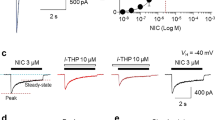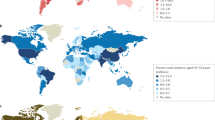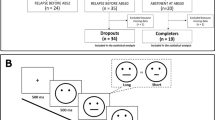Abstract
Tobacco use is estimated to be the largest single cause of premature death in the world. Nicotine is the major addictive substance in tobacco products. After cigarette smoking, nicotine quickly acts on its target, nicotinic acetylcholine receptors (nAChRs), which are widely distributed throughout the mammalian central nervous system and are expressed as diverse subtypes on cell bodies, dendrites and/or nerve terminals. Through the nAChRs in brain reward circuits, nicotine alters dopaminergic (DA) neuronal function in the ventral tegmental area (VTA) and increases dopamine release from VTA to nuclear accumbens (NA), which leads to nicotine reward, tolerance and dependence. After quitting smoking, smokers experience withdrawal symptoms, including depression, irritability, difficulty concentrating or sleeping, headache, and tiredness. Recently, evidence has been accumulated to reveal the molecular and cellular mechanisms of nicotine reward, tolerance and dependence. The outcomes of these investigations provide pharmacological basis for smoking cessation. Here, I briefly summarize recent advancements of our understanding of nicotine reward, tolerance and dependence. Based on these understandings, I propose a double target hypothesis, in which nAChRs and dopamine release process are two important targets for smoking cessation. Dysfunction of nAChRs (antagonism or desensitization) is crucial to abolish nicotine dependence and the maintenance of an appropriate level of extracellular dopamine eliminates nicotine withdrawal syndromes. Therefore, the medications simultaneously act on these two targets should have the desired effect for smoking cessation. I discuss how to use this double target concept to interpret recent therapies and to develop new candidate compounds for smoking cessation.
Similar content being viewed by others
Log in or create a free account to read this content
Gain free access to this article, as well as selected content from this journal and more on nature.com
or
References
Brennan K, Lea R, Fitzmaurice P, Truman P . Review: Nicotinic receptors and stages of nicotine dependence. J Psychopharmacol 2010; 24: 793–808.
Sargent PB . The diversity of neuronal nicotinic acetylcholine receptors. Annu Rev Neurosci 1993; 16: 403–43.
Charpantier E, Barneoud P, Moser P, Besnard F, Sgard F . Nicotinic acetylcholine subunit mRNA expression in dopaminergic neurons of the rat substantia nigra and ventral tegmental area. Neuroreport 1998; 9: 3097–101.
Sgard F, Charpantier E, Barneoud P, Besnard F . Nicotinic receptor subunit mRNA expression in dopaminergic neurons of the rat brain. Ann N Y Acad Sci 1999; 868: 633–5.
Le Novere N, Corringer PJ, Changeux JP . The diversity of subunit composition in nAChRs: evolutionary origins, physiologic and pharmacologic consequences. J Neurobiol 2002; 53: 447–56.
Klink R, de Kerchove d'Exaerde A, Zoli M, Changeux JP . Molecular and physiological diversity of nicotinic acetylcholine receptors in the midbrain dopaminergic nuclei. J Neurosci 2001; 21: 1452–63.
Yang K, Hu J, Lucero L, Liu Q, Zheng C, Zhen X, et al. Distinctive nicotinic acetylcholine receptor functional phenotypes of rat ventral tegmental area dopaminergic neurons. J Physiol 2009; 587: 345–61.
Champtiaux N, Gotti C, Cordero-Erausquin M, David DJ, Przybylski C, Lena C, et al. Subunit composition of functional nicotinic receptors in dopaminergic neurons investigated with knock-out mice. J Neurosci 2003; 23: 7820–9.
Mansvelder HD, Keath JR, McGehee DS . Synaptic mechanisms underlie nicotine-induced excitability of brain reward areas. Neuron 2002; 33: 905–19.
Wonnacott S, Kaiser S, Mogg A, Soliakov L, Jones IW . Presynaptic nicotinic receptors modulating dopamine release in the rat striatum. Eur J Pharmacol 2000; 393: 51–8.
Garzon M, Vaughan RA, Uhl GR, Kuhar MJ, Pickel VM . Cholinergic axon terminals in the ventral tegmental area target a subpopulation of neurons expressing low levels of the dopamine transporter. J Comp Neurol 1999; 410: 197–210.
Hulihan-Giblin BA, Lumpkin MD, Kellar KJ . Acute effects of nicotine on prolactin release in the rat: agonist and antagonist effects of a single injection of nicotine. J Pharmacol Exp Ther 1990; 252: 15–20.
Sharp BM, Beyer HS . Rapid desensitization of the acute stimulatory effects of nicotine on rat plasma adrenocorticotropin and prolactin. J Pharmacol Exp Ther 1986; 238: 486–91.
Xiao Y, Fan H, Musachio JL, Wei ZL, Chellappan SK, Kozikowski AP, et al. Sazetidine-A, a novel ligand that desensitizes alpha4beta2 nicotinic acetylcholine receptors without activating them. Mol Pharmacol 2006; 70: 1454–60.
Dani JA, Heinemann S . Molecular and cellular aspects of nicotine abuse. Neuron 1996; 16: 905–8.
Dani JA, Ji D, Zhou FM . Synaptic plasticity and nicotine addiction. Neuron 2001; 31: 349–52.
Wooltorton JR, Pidoplichko VI, Broide RS, Dani JA . Differential desensitization and distribution of nicotinic acetylcholine receptor subtypes in midbrain dopamine areas. J Neurosci 2003; 23: 3176–85.
Fant RV, Buchhalter AR, Buchman AC, Henningfield JE . Pharmacotherapy for tobacco dependence. Handb Exp Pharmacol 2009; (192): 487–510.
Paterson NE . Behavioural and pharmacological mechanisms of bupropion's anti-smoking effects: recent preclinical and clinical insights. Eur J Pharmacol 2009; 603: 1–11.
Sidhpura N, Redfern P, Wonnacott S . Comparison of the effects of bupropion on nicotinic receptor-evoked [(3)H]dopamine release from rat striatal synaptosomes and slices. Eur J Pharmacol 2007; 567: 102–9.
Slemmer JE, Martin BR, Damaj MI . Bupropion is a nicotinic antagonist. J Pharmacol Exp Ther 2000; 295: 321–7.
Rollema H, Hajos M, Seymour PA, Kozak R, Majchrzak MJ, Guanowsky V, et al. Preclinical pharmacology of the alpha4beta2 nAChR partial agonist varenicline related to effects on reward, mood and cognition. Biochem Pharmacol 2009; 78: 813–24.
Mihalak KB, Carroll FI, Luetje CW . Varenicline is a partial agonist at alpha4beta2 and a full agonist at alpha7 neuronal nicotinic receptors. Mol Pharmacol 2006; 70: 801–5.
Bian CF, Duan SM, Xing SH, Yu YM, Qin W, Jin GZ, et al. Interaction of analgesics and l-stepholidine. Acta Pharmacol Sin 1986; 7: 410–3.
Zhang ZD, Jin GZ, Xu SX, Yu LP, Chen Y, Jiang FY, et al. Effects of l-stepholidine on the central nervous and cardiovascular systems. Acta Pharmacol Sin 1986; 7: 522–6.
Xiong ZL, Sun Z, Jin GZ, Chen Y . [Influence of l-stepholidine on blood pressure and its relation to alpha-adrenoceptors]. Acta Pharmacol Sin 1987; 8: 497–501.
Chu H, Jin G, Friedman E, Zhen X . Recent development in studies of tetrahydroprotoberberines: mechanism in antinociception and drug addiction. Cell Mol Neurobiol 2008; 28: 491–9.
Yang Z, Shao YC, Li SJ, Qi JL, Zhang MJ, Hao W, et al. Medication of l-tetrahydropalmatine significantly ameliorates opiate craving and increases the abstinence rate in heroin users: a pilot study. Acta Pharmacol Sin 2008; 29: 781–8.
Wang H . Cardiovascular ATP-sensitive K+ channel as a new molecular target for development of antihypertensive drugs. Acta Pharmacol Sin 1998; 19: 397–402.
Wang H, Zhang YL, Tang XC, Feng HS, Hu G . Targeting ischemic stroke with a novel opener of ATP-sensitive potassium channels in the brain. Mol Pharmacol 2004; 66: 1160–8.
Yang Y, Liu X, Long Y, Wang F, Ding JH, Liu SY, et al. Systematic administration of iptakalim, an ATP-sensitive potassium channel opener, prevents rotenone-induced motor and neurochemical alterations in rats. J Neurosci Res 2005; 80: 442–9.
Chen H, Yang Y, Yao HH, Tang XC, Ding JH, Wang H, et al. Protective effects of iptakalim, a novel ATP-sensitive potassium channel opener, on global cerebral ischemia-evoked insult in gerbils. Acta Pharmacol Sin 2006; 27: 665–72.
Liu Y, He HR, Ding JH, Gu B, Wang H, Hu G . Iptkalim inhibits cocaine challenge-induced enhancement of dopamine levels in nucleus accumbens and striatum of rats by up-regulating Kir6.1 and Kir6.2 mRNA expression. Acta Pharmacol Sin 2003; 24: 527–33.
Hu J, Lindenberger K, Hu G, Wang H, Lukas RJ, Wu J . Iptakalim as a human nicotinic acetylcholine receptor antagonist. J Pharmacol Exp Ther 2006; 316: 914–25.
Hu J, DeChon J, Yan KC, Liu Q, Hu G, Wu J . Iptakalim inhibits nicotinic acetylcholine receptor-mediated currents in dopamine neurons acutely dissociated from rat substantia nigra pars compacta. Neurosci Lett 2006; 403: 57–62.
Yildirim MA, Goh KI, Cusick ME, Barabasi AL, Vidal M . Drug-target network. Nat Biotechnol 2007; 25: 1119–26.
Hopkins AL . Network pharmacology. Nat Biotechnol 2007; 25: 1110–1.
Acknowledgements
Work toward this project was supported by grants from the Arizona Biomedical Research Commission, the Institute for Mental Health Research, and Philip Morris International through their External Research Program.
Author information
Authors and Affiliations
Corresponding author
Rights and permissions
About this article
Cite this article
Wu, J. Double target concept for smoking cessation. Acta Pharmacol Sin 31, 1015–1018 (2010). https://doi.org/10.1038/aps.2010.137
Received:
Accepted:
Published:
Issue date:
DOI: https://doi.org/10.1038/aps.2010.137
Keywords
This article is cited by
-
Levo-tetrahydropalmatine inhibits α4β2 nicotinic receptor response to nicotine in cultured SH-EP1 cells
Acta Pharmacologica Sinica (2022)



